St. Louis’ Latest Folly: New NFL Stadium
The Rams Task Force unveiled its proposal for a new open-air stadium in downtown St. Louis last Friday:
The proposed location of the new stadium is on the North Riverfront, adjacent to Laclede’s Landing, sitting on over 90 acres of privately and publicly owned property. The completion date would be set no later than 2020. (KSDK)
The reactions to Friday’s announcement of a proposal for a new stadium were swift and varied; some liked it, others habte it. It was suggested it’ll never happen, it’s just a way for politicians to say they tried their best to keep the Rams from leaving or Kroenke is set on LA, he’ll never go for it. Unlike when we failed to get an NFL expansion team and we had to attract an existing team, now all we need to do make the proposal attractive enough so the NFL owners don’t vote to allow the Rams to leave — except that Kroenke seems willing to build a new LA stadium, move the team, and fight his fellow NFL owners in court. The truth is likely a combination of all these.
Rather than rush out a post, I wanted to visit the area again in person before putting my thoughts down. My previous visit was in May 2012, passing through on Amtrak.
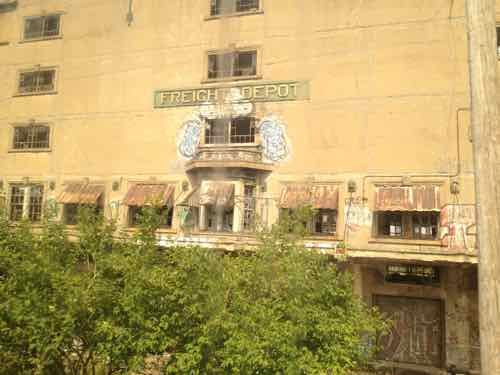
Hopefully this won’t go forward, but we must act as if it will to help block it.
- The proposal with images.
- Map link.
The good:
- Proposed stadium not within the CBD (Central Business District): I’ve been posting for years that NFL has no place in a CBD, they play too few games and the tailgate tradition means surface parking — both bad if you desire a 24/7 downtown. For these reasons, other cities have placed their stadiums just outside their CBD
- Recognition of need to connect two areas long separated by highway: Two long-neglected areas on each side of I-44, previously I-70, each need investment and access to each other.
- Open-air, dual use for soccer: Open air is much nicer than dark and closed (EJD), weather permitting. Major League Soccer (MLS) is expanding, we could get an expansion team if we build a stadium. This sounds vaguely familiar…
- Would retain the Ashley Street Power House, a city landmark.
And the bad:
- Bad use of public resources, see Nicklaus: Stadium may sparkle, but it’s not an investment: “St. Louis is being asked to pay dearly for the prestige of remaining an NFL city, so I think Peacock described his stadium plan accurately when he called it a “crown jewel.” A jewel can sparkle and make its owner feel good, but it’s hardly a productive use of half a billion dollars.”
- Would destroy recently completed (April 2013) $10 million+ transitional housing project called Stamping Lofts, halt plans for future phase to create urban farming jobs know as FarmWorks.
- Would destroy the unique Cotton Belt building (shown above), individually listed on the National Register of Historic Places for over a decade.
- Would destroy the William Kerr Foundation building, a state of the art green building.
- Would destroy the Laclede Power building.
- Would wipe out most of the North Riverfront Industrial Historic District & the North Broadway Wholesale and Warehouse District, both listed on the National Register of Historic Places,in 2003 & 2010, respectively.
- Would destroy numerous vacant warehouses that could be used for offices and/or residential.
- Would force numerous businesses to close or relocate.
- The railroad isn’t likely to agree to routing their track to the West of this new stadium, in a ditch. Leaders must’ve forgotten about the legal battles won by the railroad when designers want the track moved for the Arch, see tunnel.
- Although MetroBus service exists, light rail isn’t close.
Let’s take a look:
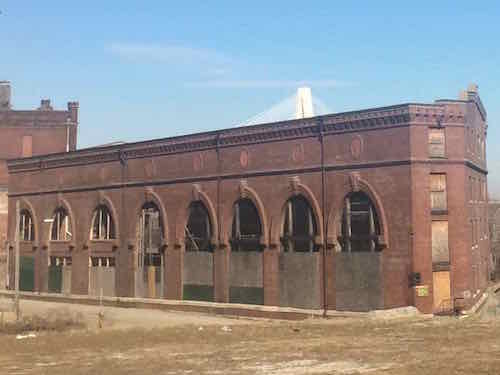
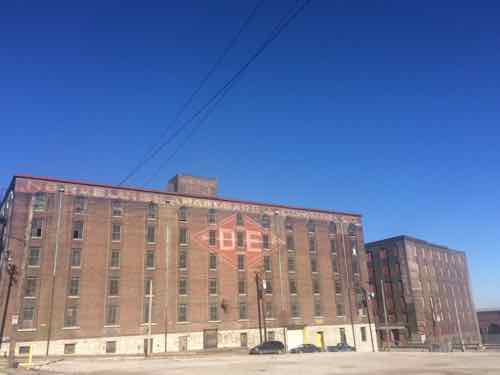
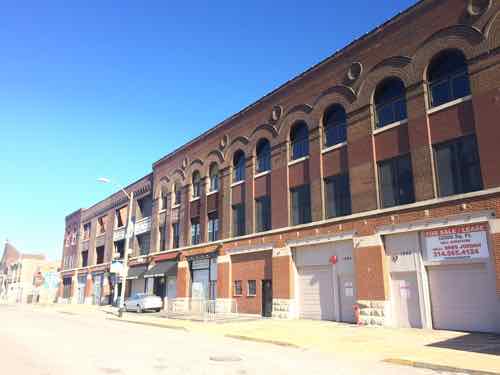
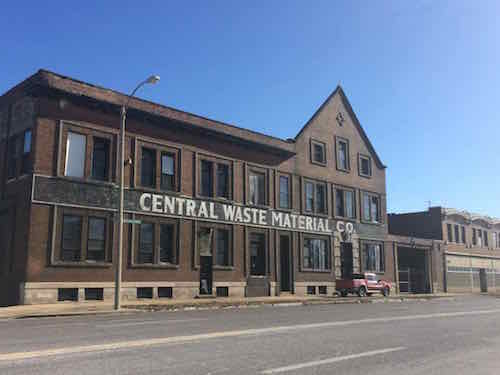
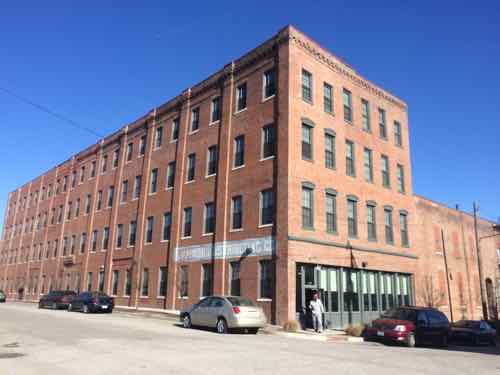
For years now this area has been coming together, with two National Register historic districts and one individually-listed building, substantial investments have been made to numerous buildings as a result. Don’t our leadership care about the investments, businesses, and year-round jobs? Sadly, as I pointed out yesterday, St. Louis began planning to raze a hotel less than a decade after it opened.
It also seems like every decade our leadership wants to raze a historic building — this would let them take away two entire districts and an individually-listed building. It’s been just over a decade since the wrecking ball began taking down the Century Building, so they’re on schedule I suppose. This area is also likely targeted because the owners of Lumière Place Casino and Hotels and Bissinger’s don’t like the rest of the area between them.
I’ll end with an open note to Rams owner Stan Kroenke:
Mr. Kroenke:
There are lots of large vacant sites in the St. Louis region where you could build a stadium. I say you build it because you’re a real estate developer, you know the value of owning the real estate. More importantly, I want you to own any new stadium so you’ll reinvest your profits in it as you see fit, also making it harder to walk away in 10-20 years.
You can do something else with your property in Inglewood, CA, but I think you already know prime property like that has many potential projects. Hell, build a stadium on it for another NFL team. But please, don’t accept the task force proposal — we’d lose too much and gain…more public debt.
So build elsewhere in the region or move the team back to LA!
— Steve Patterson
I agree with your positives. I agree with some of your negatives. I agree with the sentiments in your open letter to Stan. But there are two areas where I have issues. One, two of your six pictures show vehicles parked on the public sidewalk. If that’s an issue at the Peabody Opera House, it should be an issue, here, as well. And two, an historic designation, be it for a structure or a district, is not, and should not, be the final determination for any future use. We’re a city that has lost 2/3 of our peak population, we have vacant buildings, and some, even “historic” ones, will never, ever be reused. Just because someone or some group has some vague “plans for a future phase to create urban farming jobs” or “would destroy numerous vacant warehouses that could be used for offices and/or residential” or “would force numerous businesses to close or relocate” is no reason not to consider other options. The historic designation creates tax incentives and limits the opportunities for “insensitive” modifications, but it does not (and should not) protect any building from demolition.
I’ll repeat, if you want to “save” a building, find a viable use for it! It’s much harder to justify tearing down an occupied structure than it is to tear down a vacant one. And if you truly want to “save” many of these buildings, putting an NFL stadium on the river just might do that – most of these buildings are in the cross hairs, with or without this plan, just to create surface parking lots. The only reason most are still standing is that there really hasn’t been a good reason to spend the money to tear them down. Yes, surface parking needs to be provided for tailgaiters, but not everyone going to the game wants to tailgate. If the stadium becomes reality, here, guess what? Those old buildings just got a lot more valuable! If a public entity is doing the land assemblage, they’re going to need to pay market rates for the properties, even with condemnation. More sports bars will want to be here than would ever want to be here without a stadium.
Stan wants revenues, period. He doesn’t care if the spaces are in structures or surface lots. Get creative – promise him all the gameday revenues from, and 50 free shuttle buses between, the existing Busch Stadium garages and the new stadium. It’s “just business”, make the numbers work! The current proposal is focused on the stadium, not the neighborhood. Making everything parking, for initial discussion purposes, is the easy way out, but certainly not the only answer. And much like BPV, having convenient parking for the existing structures on non-game days isn’t a bad thing, either. As for the railroad, it’s “just business”, as well. They won’t pay to move anything, the taxpayers will. It’s a hurdle, but it’s far from insurmountable.
Like you, I don’t want to see any more tax dollars wasted on any NFL team. Unlike you, I’d rather try and figure out a win-win solution for any proposal than to just say no . . .
Yes, people parked on sidewalks. The same sidewalks aren’t accessible because the city has ignored the area for decades. I know because a few years ago I visited the area in my wheelchair. That’s not a reason to raze buildings, ignore recent efforts.
The historic districts & individually listed building are an effort to hold on to just a fraction of our history — we’ve lost a far greater percentage of our buildings than of our population. We could have far more historic districts but the loss of buildings has erased those to memories.
I’m thankful we have left the little bit we do — but now the Gov’s task force wants to take that away as well. This area has great potential — rehabbing the historic buildings and infilling. This vision has been in the works for about 20 years now and it’ll continue unless greed & hubris pulls the rug out.
I agree, parking on the sidewalk is no reason to raze any building. My point is that quality urban living requires enforcing existing rules and standards in all neighborhoods, not just those inhabited by “squeaky wheels”. You shouldn’t excuse and ignore it, here, and bitch about it repeatedly, downtown. If you want a walkable city, it needs to be a priority everywhere, not just within the range of your daily travels.
That said, we obviously have a different perspective on “historic” buildings and districts. I like old buildings. I like their details, their materials, the craftmanship many exhibit and how they create an urban fabric. Unfortunately, EVERY building and every “district’ has a “history”, even one that is just 5 or 10 years old. Every building and every neighborhood can be analyzed and categorized by distinct architectural qualities. A good wordsmith, along with a good researcher, can put together a credible application for pretty much any structure or area. Identifying 5% of the city as unique is a good thing, identifying 60% or 80% is NOT!
Cities are organic, they’re not living museums. They can and do change as people and businesses move in and out. The real problem is that most historic designations, for both buildings and, especially, districts, assume some arbitray point in time is where life should be frozen, apparently forever and ever. Around here, that seems to be 1925, in Palm Springs, it’s 1960. People who like a certain style or look use historic districts to impose their preferences on their neighbors and other property owners. And as styles change (as they inevitably do), the conflicts between those who favor new and those who favor old can and do become more and more apparent.
I have no issue with individual property owners seeking the benefits of historic designation. Where I have an issue is when advocates wrap themselves in the mantle of history and seek to impose their will on others. Red brick is not inherently superior to blonde brick. Stucco is not inherently superior to vinyl siding. Zoning can and should be used to define height and bulk, but there is little public purpose in the government dictating finish materials or mullion widths.
The other half of the equation is just how long do we wait?! You state that the “vision has been in the works for about 20 years now”. Do we wait 10 more? 20? 30? 50? While driving by underused and vacant structures and lots? When do we admit that it’s just not working? That maybe we need to try a new direction? There are more than a few parts of the city, including this one, that have been in continuous decline for more than half a century. The definition of insanity is doing the same thing over and over and expecting a different result. Yes, there have been a few recent projects. Great! But do we just say “no” to one big one just because a dozen, much smaller, ones “might” (might!) “happen”?! “Potential” doesn’t pay the bills or put people to work!
We need to change St. Louis’ image from rust belt to someplace people want to be and want to invest. We don’t want to be Detroit or Cleveland, we want to be Chicago or Pittsburgh. We need to figure out how to occupy acres of vacant land and hundreds of vacant structures. Historic designations are one tool, but they’re just that, one tool, not the only tool. Demolition for something better is not always a bad thing (and yes, “better” is always debatable). I’m more willing to do something, many times, and see some mistakes, than to do nothing, and see our population continue to decline, in both numbers and demographics. I don’t want to be the city where “will the last one out, turn off the lights?”!
I don’t necessarily disagree with your general assessment of balancing historic preservation opportunities with moving forward with something else, but as applied to this specific proposal the historic preservation side of the ledger wins easily imo. The proposal would level non-blighted buildings, kick out people from apartments, kick out tax-paying businesses and a foundation, and foreclose any opportunity for additional redevelopment of the remaining underutilized or vacant buildings as well as infill. This proposal would be great perhaps for the other side of the riverfront but not here where there is terrific opportunity.
And I agree – if you mean across the river, in Illinois. The challenges, south along the Missouri side of the riverfront, are similar to those, here. On the other side, in Illinois, are acres of unused brownfields. Yes, it’s subject to flooding, but who cares if it’s all surface parking?
I hope he just moves his team we are going to destroy a part of the city for 8 football games a year and for people who go to the games that wont spend any money downtown and what nothing to do with the city. There is a reason the city lost 2/3 of its people it was planning like this.
so lets let the rams move to LA and use all the money for a better plan for downtown.
we can use the money to build a new convention center with a 1000 car underground parking garage at the bottle district site. Then after it is built demo the old dome and convention center and rebuild the street grid zone for mid to high rise mixed use development. This would be a lot better and bolder project than the current rams plan.
I enjoyed your overview of the area and appreciate the fact that this general area was selected for the stadium in the sense that it puts a spotlight on it and hopefully leads to a productive discussion of how best to move forward with utilizing its potential.
I’ll also note that GRG now owns the Laclede Power Building and I’d say that if left standing, it is almost certain to be utilized as part of GRG’s comprehensive master plan to significantly enhance the area. The Central Riverfront Trail improvements already under construction from the Arch grounds will be completed by the end of the year and will terminate at the Biddle Street/North Riverfront Trailhead at the foot of the Union Electric plant.
On the whole, I like the plan (though not the “public” portion of the total bill).
Any urban-minded person can see the quality of the old brick warehouses located there, but the progress to utilize it has been slow-to-nonexistent.
A happy medium would be to start to project area north of O’Fallon in order to preserve both the William Kerr Foundation building and the Laclede Power Station. Maybe the other buildings can be re-utilized too, or new development springs up from their footprints.
A soft touch regarding the adjacent Broadway buildings would be nice — save some, demo others, build new/modern mixed-use where possible. By relocating the work house and grainery (if possible), you can effectively “hide” parking behind Bissinger’s factory and scoot the whole site plan up a bit.
I actually don’t mind a fair amount of parking for this, though an effort should be made to determine exactly how much is actually necessary. Some people just want to park, not tailgate, so maybe a partially-buried double or tri-deck garage can serve them. For the tailgaters, sure, give them 3,500 spots or so spread out to the west and north of the stadium. Soldier Field, for instance, has less surface parking than the STL plan (and a large garage), but their die-hards do just fine with it.
I would love to take a riverfront bike ride past the arch, through a revitalized Laclede Power Station and Trailhead, and up to the river-side doors of a new open-air stadium. There’s also potential for some sort of riverfront trolley and, probably unlikely, some new excursion boats.
Most exciting is the (potential) renewed focus on St. Louis’ riverfront and adjacent neighbors. I’m imagining some high-rises finally going up at the Bottle District (imagine the view!) and some industrious entrepreneurs finding renewed opportunity in Laclede’s Landing and North Broadway past the Stan.
I think the suggestion of perhaps moving the stadium one block north has been pretty common and it would be doubly awesome get relocate the workhouse and that tank/storage facility…. talk about blight!
But the more I look at the Farmworks and Cotton Belt visions, the more I’d lament their loss. If those two projects come to fruition, you’d have a great outcome for almost the entire border of the northern section of the proposed site plan. The “Migrate” mural on the Cotton Belt is really cool and if they can execute the additional phases contemplated that would be one sweet place.
It’s always easier to spend other people’s money, isn’t it? You make it sound as if developers are leaping over themselves to have this property.
It’s always easier for billionaires to get what they want, even if it means destroying properties that developers have invested millions in within the last decade.
Yes, it sure looks like millions have been invested.
Haven’t your opinions been rendered moot on this topic once you avowed not to support the Rams once Michael Sam was cut from the team?
$10 million on Stamping Lofts, over $1 million on the William Kerr Foundation HQ. The optimistic artist renderings don’t show the ongoing investment that’s been made.
The Rams can stay or go, I don’t care. My interest is in keeping the region & state from making another bad deal.
$11M-$15M (?) over the last 10-15 years (?) versus $850M-$900M in direct investment, plus a minimum of $5M-$10M in spin-off projects, within 5 years? I get it, I like seeing smaller projects succeed, as well. I also like looking at the bigger, total picture. Both compromise and politics are the art of the possible. I also see no need to subsidize any NFL team, but I’m going to rely on financial arguments, not trumped-up design hurdles. (And I’m assuming that any recent developments will receive fair market value for their properties, should they be needed.)
$10 million plus was in the Stamping Lofts, that opened less than two years ago. The William Kerr Foundation has been completed for 10-15 years now. Just north of the area (across the street) Bissinger’s chocolates bought & rehabbed one of those previously vacant warehouses — it wouldn’t be razed and I didn’t have time to look up the cost. Looks like they paid $4 million for the building and planned to spend at least $11 million.
And that’s why I didn’t include anything outside the project boundary! If an old structure gets demolished, it’ll likely be beacuse the owner has other plans for the property. If an old structure gets renovated, it’ll likely be because of its proximity to the larger project and the owner sees the potential for higher financial returns. (And Bissinger’s ain’t going anywhere!) Remember, the current proposal is just that, the first step in a long process. Less than 20% of the land area is new stadium, more than 80% is parking. The proposal identifies a “need” for 22,000 parking spaces and shows, conceptually, less than half that, with 5,000 spaces in new structures and 5,000 in surface lots. Those numbers and ratios can (and will) change. Stan doesn’t want to be in the parking business, Stan wants the revenue that can be generated on game days. Can public transit be better integrated into the project (as it is in many other cities – Cleveland and Denver come immediately to mind)? Is there / will there be any attempt to “manage” parking, and use existing, nearby lots and structures? It all boils down to $$$$$$ – if an historic building can generate more by being replaced by parking, it will be demolished. If an historic building can generate more by being renovated (with parking being done elsewhere), it will be preserved – it’s just business. And much like BPV, where “too much” land remains as surface parking, surface parking ain’t forever, it will get replaced if and when it makes economic sense to do so!
The other half of this discussion is just what is the “highest and best use” for urban land? Is it for a stadium (and surface parking) used less than a couple of dozen days every year? Or, for an “urban farm”? (Which, to many people, would constitute an oxymoron – rural areas equal farming, urban areas equal not farming!) Or, something else? FarmWorks is an interesting concept for putting abandoned industrial properties to (a better? any?) use, but is it the “best” use? It still seems to be a “work in progress”, more concept than reality, so there still seems to be a lack of proof of concept: http://farmworksstl.com/
There is one city where urban farming is currently taking hold, big time, primarily in older warehouses, and that’s Denver, where legalized marijuana has created a significant new market for four walls and a roof. Legalizing recreational marijuana would do the same thing, here, at least initially, because we have the supply, all we need is the demand!
Good question on the progress of FarmWorks…. this phase was set to begin around this time with the successful completion of the Stamping Lofts housing portion but I haven’t heard to much about it recently. Some work on the methane production facility appears to have started so hopefully things are going well. We can’t complain about Larry Rice & NLEC, etc. and not support these types of more productive programs for tackling the homeless issue.
Essentially what was presented to the public was spending around $300 million in public money for land clearance and site prep… questionable to call that direct investment, especially considering that it would require the removal of many functioning buildings and businesses, etc. On top of that, another $200 million or so in public funding would be used to build the stadium itself. That is awfully expensive final bill with questionable returns. If they so desired, economic development authorities could decide to be active in the area and provide additional incentives to speed up redevelopment of the area at a fraction of the $500 million being contemplated here.
I poked around the site this afternoon – it appears that more than half of it, both buildings and land, is currently vacant and abandoned. I guess the real question is if there is enough old stuff remaining (that is salvagable) to justify a large public investment in tentative, at best, redevelopment efforts? Or, would there be less risk to the public, and more return on our investment, if the site were cleared, and much of the current proposal implemented? (I seriously don’t know, at this point.) In addition, I’d guess that less than half of the built square footage is occupied by what most would call thriving businesses. More than half appears to be either vacant or occupied by tenants willing to take whatever cheap space they can find.
Good for you for taking a look… did you by chance see the Migrate mural? Even if there is no stadium, GRG’s improvements, and likely utilization of the Laclede Building within a reasonable time frame, should greatly improve the area and hopefully lead to more private development interest. And if the FarmWorks project and additional phases of the Cotton Belt initiative come to fruition that would also be a huge boost to boot. The Broadway strip is pretty much fine as is. So what I’d like to see economic development authorities concentrate on is a redevelopment plan for the area containing the group of warehouses in the O’Fallon/Lewis/Ashley area… treat it like the Arcade/Wright building by entertaining proposals while letting it be known that additional subsidies may be available. I’m optimistic that a good, hopefully mixed-use plan would result. The area has a ton of potential that a modest amount of subsidy should be able to help unleash.
If there is a stadium, I’d like to see it moved one block north as some have suggested in order to keep the majority of historic buildings. That definitely would mean the loss of the Cotton Belt, though,
How did you tell the difference between “vacant” and “vacant & abandoned” buildings?
no glass in the window frames . . .
For the record, one of those w/o glass — Laclede Power — is owned by GRG and is all but assured will be be renovated if left standing. Of the five contributing buildings in the immediate area surrounding it, at least three are in use, one I believe is in use but I am not positive, and 1 has a structural condemnation issue. An ornamental iron business just moved into one of the warehouses. One was sold just prior to the recession for $2.5 million and at least one of the others has had potential owners poking around. So I’d say there is a good hope of a solid future for five of the six buildings in that area… six of seven if you include the Union Electric plant. A bit to the north is the intriguing Cotton Belt which has a great vision but will take passion and patience.
According to a Post-Dispatch article today, it turns out the warehouse that I wasn’t sure about whether was in use or not had its tenant relocate just a few months ago and is now being marketed for sale. So of the five core buildings surrounding the GRG-owned Laclede Power you have two warehouses with an operative business, two vacant and on the market and the sustainable rehab for the foundation. McGowan Bros. owns the one with the structural issues, btw.
The article also mentioned that the rail owner is open to an adjusted alignment but that the electrical substation on Broadway will be remaining. And that the power plant hasn’t had any formal talks with Peacock about moving.
Historic buildings aside I seldom attend football games but attended one earlier this year. (Dallas) I took special note of the building housing the Rams. It’s absurd, nothing is wrong with that building, it’s actually in excellent condition. What is going on represents the fantasy world of big money and government as seen in practically every action undertaken by the government these days.
The whole premise for a new stadium is so bankrupt that it is confounding anyone can believe the lies and half truths of the NFL, the city or Kroenke the evil king. Truthfully St. Louis, even with it’s flaws, is a city that doesn’t need the blessing of the NFL, who cares if they leave? What a joke being perpetuated on the people of Missouri.
I am, or was a football fan, Kroneke, the NFL and their enablers in government are nothing more than unethical and immoral bunch of thieves.
This argument isn’t about about the condition of the building. The premise isn’t bankrupt nor are the individuals involved immoral thieves. The city crafted horrible lease terms that have led up to this point.
Kroneke wouldn’t have found an excuse to invalidate any lease. The NFL and the owners have been extorting communities across the US for years. If that isn’t bankrupt or immoral, then what is it?
Yes the lease is horrible, more proof of the general incompetence of the so called leaders. What’s worse the architect was not instructed to do modular designs that could allow change in an economical manner. Even at the basic level of determining possible outcomes and directing design to allow for those possibilities shows a complete disregard of common sense That is assuming that the leaders of St. Louis weren’t also planning for the demise of the Edward Jones Dome. Which is most likely. (as long as they can soak the taxpayers for the interests of billionaires and millionaires they don’t care)
I mention the condition of the building as a way of saying the building is clearly not past its useful life. As a culture the idea we should throw everything away is still prevalent. I laugh at the ignorance. What is the Edward Jones Dome lacking? Gold encrusted masturbation chambers for the wealthy?
If the leadership of this town had any dignity they would tell the NFL and Kroneke to go to hell and stuff it .
Modular designs?! The dome already has retractable seating, so that it can double as a convention center! Other than that, building in more “flexibility” is/would have been both an exercise in voodoo prediction (Murphy’s Law says whatever you do will be wrong) and would (have) substantially increase(d) any budget in hopes that you’ll actually guess correctly. Unfortunately, the average lifespan of any NFL stadium is surprisingly short, around 40 years. The Cowboys played in Texas Stadium from 1971 through 2008: in 2009 they got their new toy. The New Orleans Superdome opened in 1975 and remains in use. The Chicago Bears have played in Soldier Field since 1971; it was extensively updated and expanded in 2003. The Denver Broncos played in the old Mile High Stadium from 1960 through 2001; in 2002 the new Mile High Stadium opened. In comparison, the Jones Dome is “only” 20 years old, yet lacks many of the “features” newer stadia enjoy. “Yes, the lease is horrible”, but it’s what we agreed to and what we’re stuck with. I agree that “If the leadership of this town had any dignity they would tell the NFL and Kroneke to go to hell and stuff it”, but that stance ignores the reality that there’s still another 10 years left on the bond payments – having a paying tenant beats not having one! Yes, the Rams SHOULD be happy with the Jones Dome for another 15 or 20 years, but, contractually, they don’t HAVE to . . . .
Thank your for “getting it.” It’s a business deal gone bad for the city. None of the parties are bad people or are incompetent.
Don’t forget the context that produced the lease — we built a stadium to get an NFL expansion team but we’re selected.
Our politicians were now stuck with a brand new stadium but no NFL team, a situation they desperately had to correct.
Why is the location for a new stadium tied to the central city? Other parts of the metro area are more accessible and the land may be cheaper. In particular, I am thinking of an area just west of Lambert-St Louis Airport. The land is bounded by Interstates 70 and 270, and highways 370 and 141. Currently this area is underutilized, with a good amount occupied to two closed landfills. Why not build the stadium there? The current owners seem to regard their properties as some kind of toxic asset, so they would probably be willing to sell for a mere song.
There are already hotels in the area, for out-town-visitors. And an extension of Metrolink from the airport out to the stadium would make the site even more accessible! What’s not to like? It would spur development of the Missouri River basin. And it would help lay the groundwork for extending Metrolink into St. Charles county.
Exactly, this region consists of at least 8 counties in two states — not everything has to be within sight of the Arch.